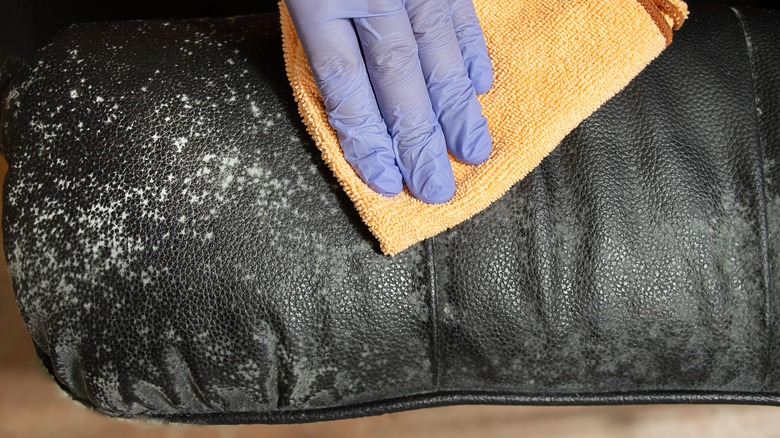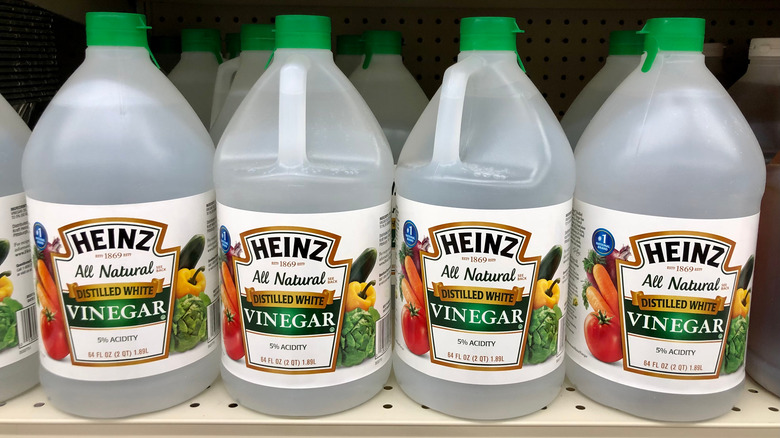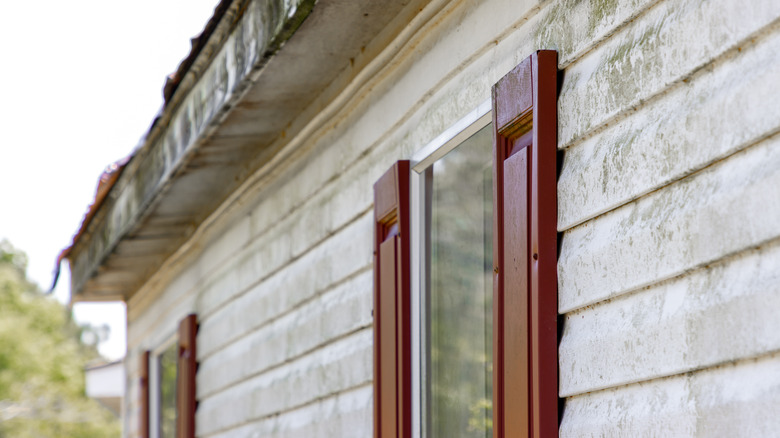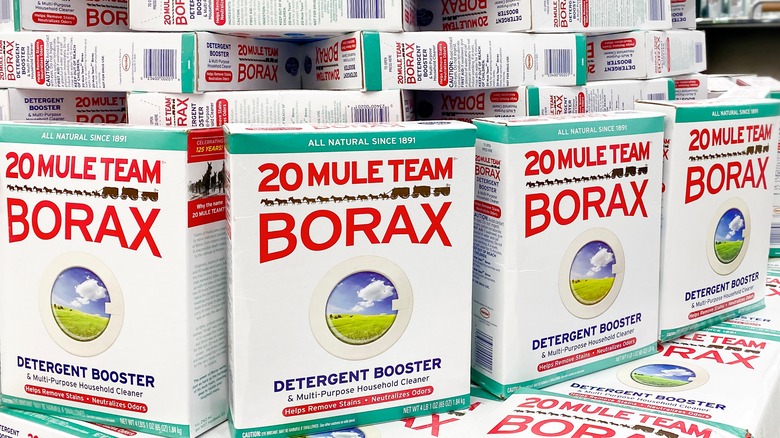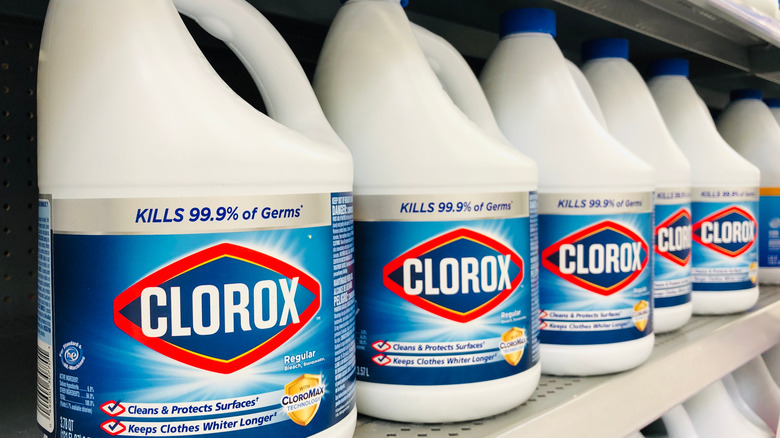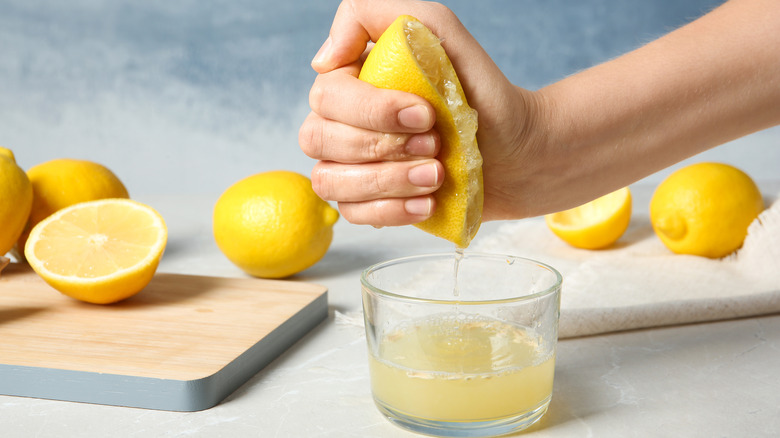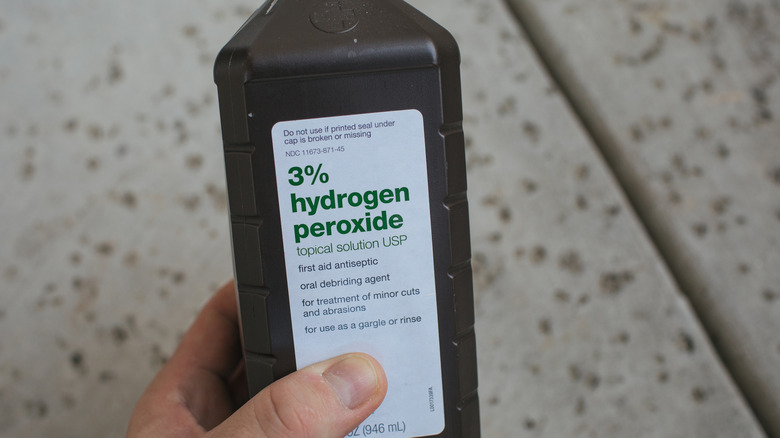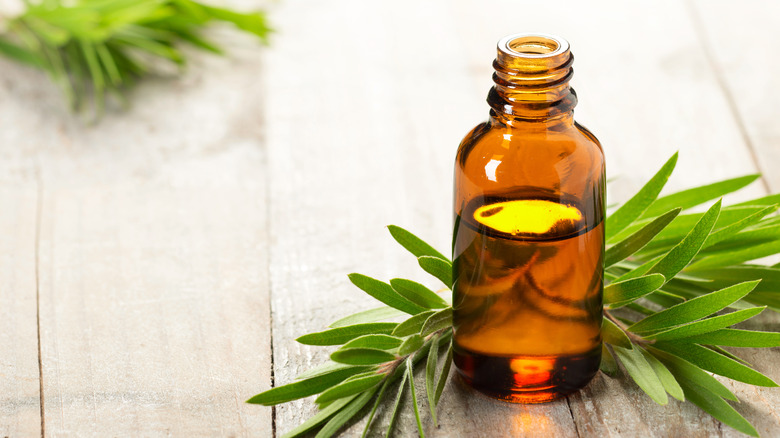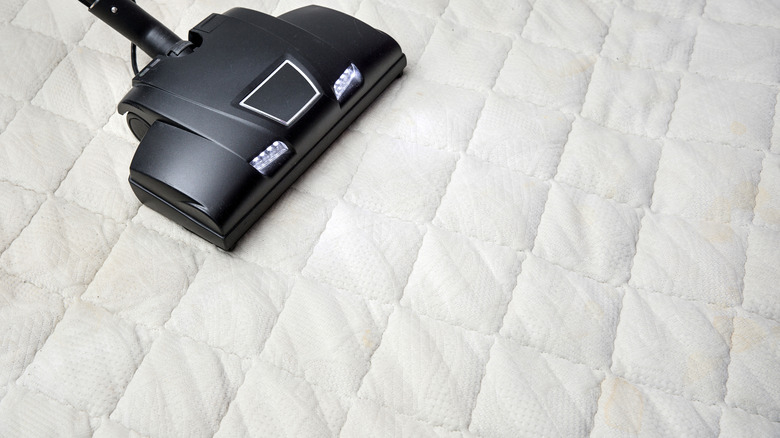8 Easiest Ways To Clean Mildew
It's never a good thing when you spot mildew in your home, but it is common to see it growing on surfaces from time to time. Mildew is a type of fungi that is generally white or gray in the early stages of its growth. It can develop just about anywhere under the right conditions. It thrives in damp areas, so you will most likely see it where moisture collects, such as window sills and shower curtains. However, you might also see it growing on food and even pieces of paper. If left untreated, it can turn into mold, which can be an even more difficult problem to remove, according to HGTV.
You can use store-bought cleaners to remove mildew from various surfaces, but the good news is that you don't have to. We have come up with eight easy ways to remove mildew, and you probably have a few of the ingredients in your home already.
White vinegar
One of the best ways to remove mildew is to use white vinegar. It has antifungal and antibacterial qualities, making it an ideal choice to combat mildew. Not only that, but vinegar can prevent mildew and mold from growing on surfaces. According to Healthline, one of the great things about vinegar is that you can use it on just about any surface. For example, it works on bathroom tiles, walls, plastic items, leather, and even clothing. That being said, vinegar isn't recommended for all surfaces. It can damage stone and porous surfaces, such as kitchen countertops. Vinegar can weaken some finishes, so it's best not to use it on wooden floors. Moreover, it can wear away certain metals like copper and aluminum.
In most cases, you can use it full strength. Put it in a spray bottle, mist it directly on the mildew, and let it sit a couple of minutes before wiping it away.
Ammonia
Ammonia is already used in many household cleaners. It breaks down greasy stains and works to get rid of dirt, according to Chemical Safety Facts. When it comes to furniture or other wooden items, ammonia might be the best choice for getting rid of mildew. Ammonia is an excellent choice for unfinished, painted, and stained wood (via SF Gate). Mix 1 cup of ammonia with ½ cup of vinegar, ¼ cup of baking soda, and 1 gallon of water for the best results. Apply the solution to the affected area, and use a brush to scrub stubborn spots. Rinse the area well, and allow it to dry outdoors in the sun.
When working with ammonia, be sure to work in an area that is well ventilated. You should never mix it with bleach because the resulting mixture will create toxic fumes. In addition, always wear gloves and protective glasses when using ammonia.
Borax
Like ammonia, borax is found in several household cleaning products as well as toothpaste and mouthwashes, per WebMD. You can also find it in cosmetics, sunscreen, pesticides, and herbicides. One of its more popular uses is to be used as a laundry booster. The white powder is made from the byproducts of minerals found in dry lake beds.
For a simple solution to remove mildew, mix 1 cup of borax with 1 gallon of warm water, and add the mixture to a spray bottle. Mist the mildew with the solution and sit for 30 minutes. Wipe the mildew away with a damp cloth. You can also use this recipe to remove mildew stains on clothing items. Apartment Therapy recommends keeping the mixture around the house and spraying it on surfaces to prevent any new mildew from forming. Wear gloves and wash your hands after using the spray because it can cause a rash. Avoid breathing it in, as it might damage your lungs or throat.
Bleach
Bleach is a general go-to for cleaning, and it works well for removing mildew from cement, bricks, stucco, and other materials used on the outside of your house. You can also use it to clean white cotton clothing. To remove mildew from clothing, follow the manufacturer's instructions for cleaning.
For areas outside the home, Clorox recommends mixing ¾ cups of bleach with 1 gallon of water. Wet the surface area before applying the solution. Dip a scrub brush with a long handle in the solution and apply it to the mildew, adding more of the mixture to keep the area wet while you scrub. Rinse the area with water. To be safe, always test bleach on a small, concealed section before tackling a large project. Don't use bleach on aluminum or unfinished wood, and it's best not to apply it on surfaces in direct sunlight. Always wear rubber gloves, rain boots, and old clothing to protect your skin.
Lemon juice
Lemons are great to keep around your home because they have many uses. You can polish pots and pans with them, as well as remove mineral deposits from coffee pots and tea kettles. You can even toss lemon peels into your garbage disposal to get rid of its funky smell, according to The Spruce. Lemon juice is antiseptic and antibacterial, making it ideal for keeping surfaces clean. But that's not all.
Because lemons are acidic, they are an excellent choice for breaking down mildew (via Hunker). It might be one of the easiest methods of removing mildew, as all you need to do is squeeze your own lemon juice and apply it to the mildew. However, you can always buy it concentrated from the store if you don't want to waste time juicing lemons. For the best results, wet the affected area before applying any juice. Simply dip a brush or sponge in the liquid and use it to scrub away mildew.
Hydrogen peroxide
Like lemon juice and vinegar, hydrogen peroxide is antimicrobial, meaning it has a multitude of uses. One of those uses is removing mildew and killing mold spores, as per Healthline. You can use it on countertops, glass, walls, and in the shower, but it is not for all surfaces. For example, you should avoid getting it on porous surfaces like wood and natural fabrics like wool because it is likely to bleach them. However, it is generally considered safe to use on many synthetic materials.
Simply pour 3% hydrogen peroxide into a spray bottle and spray it directly on the mildew for a cleaning solution. Allow it to bubble on the area for 10 minutes before scrubbing it away gently with a brush or cloth. Wipe the area with a soft cloth and repeat if some mildew remains. Don't mix hydrogen peroxide and vinegar as the resulting solution can inflame eyes, lungs, or skin.
Tea tree oil
For one of the best and easiest natural ways to remove mildew, you won't have to look any further than a bottle of tea tree oil. This incredible oil is anti-fungal and antimicrobial, and it is used to relieve a variety of conditions, including dandruff, athlete's foot, and nail fungus, according to Mayo Clinic. These properties also mean it can tackle mildew, and using it couldn't be any easier.
Apartment Therapy recommends mixing 1 teaspoon of the oil with 1 cup of water in a spray bottle. Give it a good shake, spray directly on the mildew, and let it sit for a few minutes before wiping it away. Spray it on clean surfaces to prevent mildew from returning. It might cause some stinging, itching, or redness if you get it on your skin. Use gloves if you have eczema, and do not swallow it because it has been linked to serious side effects.
Vacuum cleaner
For some surfaces — especially wood — a vacuum cleaner might be the best choice when it comes to getting rid of mildew. You'll need to use a vacuum cleaner that uses a HEPA filter that prevents vacuumed spores from escaping back into your home. Go over mildew that you see growing on walls and floors, removing as much of it as possible. Always empty the vacuum bag outside.
For upholstery, it is best to move the furniture outside to avoid releasing spores indoors. Begin by brushing as much of the mildew off the fabric as possible with a broom or small brush before vacuuming the remaining residue, as per SF Gate. You may need to employ another one of the methods we've listed if all of the mildew does not break free after you've gone over it a few times with the vacuum, according to Bob Vila.

